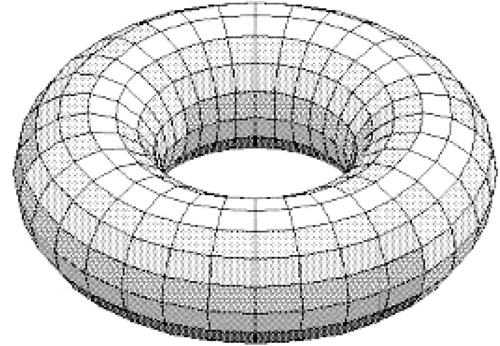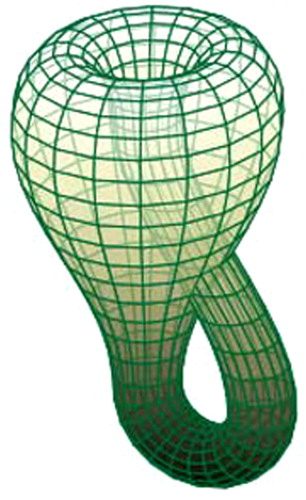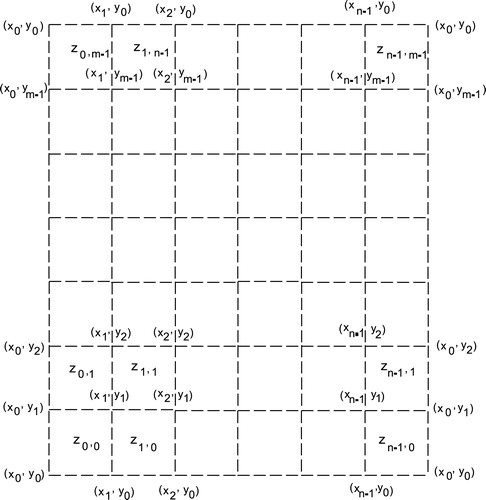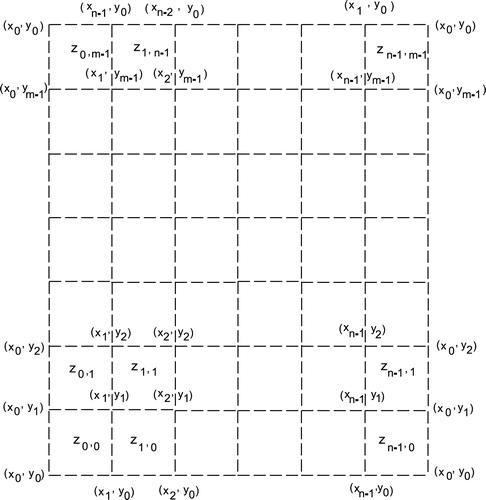 ?Mathematical formulae have been encoded as MathML and are displayed in this HTML version using MathJax in order to improve their display. Uncheck the box to turn MathJax off. This feature requires Javascript. Click on a formula to zoom.
?Mathematical formulae have been encoded as MathML and are displayed in this HTML version using MathJax in order to improve their display. Uncheck the box to turn MathJax off. This feature requires Javascript. Click on a formula to zoom.Abstract
In this paper we deal with the problem of labeling the vertices, edges and faces of a toroidal and Klein bottle
grid graphs with
4-sided faces by the consecutive integers from 1 up to
+
+
and
+
+
in such a way that the label of a 4-sided face and the labels of the vertices and edges surrounding that face all together add up to a weight of that face. These face-weights then form an arithmetic progression with common difference
. The paper examines the existence of such labelings for several differences
.
1 Introduction and definitions
Let be a family of
-regular graphs embedded on the surface of a torus or Klein bottle such that each of its face is
-sided. Let
,
and
be the vertex set, the edge set and the face set of a graph
, where
,
and
denote the cardinality of vertex, edge and face set respectively.
A labeling of type is a bijection
The weight of a
-sided face under a labeling of type
is the sum of labels carried by that face and the edges and vertices surrounding it.
A labeling of type of graph
is called
-antimagic if the set of weights of all
-sided faces is
for some integers
and
, where
is the number of the
-sided faces.
The concept of the -antimagic labeling of plane graphs was defined in [Citation1]. The
-antimagic labeling of type
for the generalized Petersen graph
, hexagonal planar maps and grids can be found in [Citation2,3] and [Citation4], respectively. Lin et al. in [Citation5] showed that prism
,
, admits
-antimagic labeling of type
for
. The
-antimagic labeling of type
for
and for several
are described in [Citation6].
In particular for , Lih in [Citation7] calls such labeling magic and describes magic (
-antimagic) labeling of type
for wheels, friendship graphs and prisms. Kathiresan and Gokulakrishnan [Citation8] provided the
-antimagic labeling of type
for the families of planar graphs with
-sided faces,
-sided faces,
-sided faces and one external infinite face.
A -antimagic labeling of type
is called super if the smallest possible labels appear on the vertices. The super
-antimagic labelings of type
for antiprisms and for
are described in [Citation9] and for disjoint union of prisms and for
are given in [Citation10]. The existence of a super
-antimagic labeling of type
for the plane graphs containing a special Hamilton path is examined in [Citation11] and a super
-antimagic labeling of type
for disconnected plane graphs is given in [Citation12]. For more details (see [Citation13]). Plane graphs can also be embedded on other surfaces like torus, sphere, Klein bottle and projective plane (see [Citation14]).
Motivated by the paper [Citation15] we deal with the super -antimagic labelings of type
for the toroidal grid and we describe those labelings for several values of
.
Let L be a regular square lattice and be an
quadrilateral section (with
squares on the top and bottom sides and
squares on the lateral sides,) cut from the regular square lattice L. First identify
lateral sides of
to form a cylinder, and finally identify the top and bottom sides of cylinder at their corresponding points; see .
Thus we get a toroidal grid graph with
-sided faces,
vertices, and
edges. More about toroidal grid can be found in ([Citation16]).
In the case of Klein bottle grid first we identify lateral side of to form a cylinder and then identify the top and bottom sides of the cylinder in opposite direction. By this identification of
, we get Klein bottle grid graph
with
-sided faces,
vertices, and
edges. see .
2 Necessary conditions
In this section, we shall find bound for a feasible value of for the super
-antimagic labeling of type
for the toroidal grid
and Klein bottle grid
.
Let be such a labeling. We consider weights of
-sided faces of the toroidal grid separately for a vertex labeling, an edge labeling and a face labeling. For
-antimagic vertex labeling
the minimum possible weight of a
-sided face is at least
and the maximum weight of a
-sided face is no more than
Thus
and
Lemma 1
For every toroidal grid ,
,
, there is no
-antimagic vertex labeling with
.
Assume that has a
-antimagic edge labeling
with
values from the set
. Then the minimum possible weight of
-sided face is at least
and the maximum weight of
-sided face is no more than
Hence
It is easy to see that
Lemma 2
For every toroidal grid ,
,
, there is no
-antimagic edge labeling with
.
According to Lemma 1, Lemma 2 and the fact that under a -antimagic face labeling
with
values from the set
the parameter
is no more than
, we obtain the following theorem.
Theorem 1
Let ,
,
, be a toroidal grid graph which admits
-antimagic vertex labeling
,
-antimagic edge labeling
and
-antimagic face labeling
. If the labelings
,
and
combine to a super
-antimagic labeling of type
then the parameter
.
Remark 1
Similarly, we can estimate the bound for the Klein bottle grid graph.
3

 -antimagic labeling of toroidal grid graph
-antimagic labeling of toroidal grid graph
Let be the vertex set of the graph
,
be the edge set and
be the face set with indices
and
taken modulo
and
respectively. The face
is bounded by edges
,
,
,
. (See ).
In this section we will use a similar idea which was used for an investigation of -antimagic labeling of generalized prism in [Citation17].
Lemma 3
Let
be toroidal grid and let
and
. If
and
, then the partial weights of
under the labeling
for every
, constitute an arithmetic sequence of difference
and for
the partial weights
constitute the sequence
.
Proof
Under the labeling , for every
,
, the partial weights of
-sided faces
are as follows:
(1)
(1) This shows that for every
,
,
, the partial weights of
form the arithmetic sequence with difference 2 from
up to
and for every
,
, the partial weights of
form the arithmetic sequence with difference 2 from
up to
.
Lemma 4
Let
be toroidal grid and let for every
,
If
and
, then under the labeling
the partial weights of
, for every
,
, form an arithmetic sequence of difference
.
Proof
The partial weights of the -sided faces
under the labeling
, for every
,
, admit values
(2)
(2)
This shows that the partial weights of form the arithmetic sequence with difference 1 from
up to
.
Lemma 5
Let for every ,
If
and
, then the partial weights of
under the labeling
, for every
,
constitute an arithmetic sequence of difference
.
Proof
The partial weights of the -sided faces
under the labeling
, for every
,
, attain values
(3)
(3) Thus, under the labeling
the partial weights of
-sided faces
,
,
, constitute the arithmetic sequence of difference 1 from
up to
and for
the partial weights
attain consecutive values
.
Theorem 2
For and
, the toroidal grid graph
has a super
-antimagic labeling and a super
-antimagic labeling of type
.
Proof
Case d=1.
It follows from Lemmas 3 and 4 that under the labeling and
the weights of all
-sided faces are
This shows that the weights of the
-sided faces form an arithmetic sequence with difference 1 starts from
up to
.
Case d=3.
Taking into account Lemmas 3 and 5 we can see that under the labeling and
the weights of
-sided faces are
Thus the weights of all
-sided faces constitute an arithmetic sequence of the difference
, namely
up to
.
4

 -antimagic labeling of Klein bottle grid graph
-antimagic labeling of Klein bottle grid graph
Let be the vertex set,
be the edge set and
be the face set. The face
is bounded by edges
,
,
,
, for
and
is bounded by edges
,
,
,
for
and
is bounded by edges
,
,
,
, (see ):
Lemma 6
Let and
. If
and
, then under the labeling
the partial weights of
for every
,
,
, constitute an arithmetic sequence of difference
and the partial weights of
for
are
and for
and
are
.
Proof
Under the labeling , for every
,
, the partial weights of
-sided faces
are as follows:
(4)
(4) This shows that for every
and
,
,
, the partial weights of
-sided faces
form the arithmetic sequence with difference 2 from
up to
. For
the partial weights of
are
and
.
Lemma 7
Let
If
and
, then the partial weights of
under the labeling
for every
and
,
,
, constitute an arithmetic sequence of difference
.
Proof
Under the given labeling , for every
,
, the partial weights of the
-sided faces, admit the following values
(5)
(5)
(6)
(6) This shows that the partial weights of
-sided faces form the arithmetic progression with difference 1 with values from
up to
.
Lemma 8
Let
If and
, then the partial weights of
under the labeling
, for every
,
, constitute an arithmetic sequence of difference
.
Proof
Under the labeling , for every
,
, the partial weights of the
-sided face attain values
.
(7)
(7) Thus partial weights of
-sided faces under the labeling
, constitute the arithmetic sequence of difference 1.
Lemma 9
Let
If
and
, then the partial weights of
under the labeling
, constitute an arithmetic sequence of difference
.
Proof
Under the labeling defined for
in Lemma 8 and for
defined above, the partial weights of the
-sided face attain values
(8)
(8) Thus weights of
-sided faces under the labeling
, constitute the arithmetic sequence of difference 1.
Theorem 3
For and
, the Klein bottle grid graph
admits a super
-antimagic labeling and a super
-antimagic labeling of type
.
Proof
Case d=1. It follows from Lemmas 6 and 7 that under the labeling and
the weights of all
-sided faces are
This shows that the weights of the
-sided faces form an arithmetic sequence with difference 1 with values from
up to
.
Case d=3.
Taking into account Lemmas 6, 8 and 9 along with the following swapping
| • | |||||
| • | |||||
| • | |||||
| • | |||||
| • | |||||
we can see that under the labeling and
the weights of
-sided faces are
Finally the weights of the all
-sided faces of given graph form an arithmetic progression with the common difference
, starting from
up to
.
5 Conclusion
In this paper we examine the existence of super -antimagic labeling of type
for toroidal grid graph
and Klein bottle grid graph
. We show that
and
admit a super
-antimagic labeling of type
for
, for all
. However we tried to describe a super
-antimagic labeling of type
of graphs
and
for
but without success.
Therefore we conclude the paper with the following open problem.
Open problem 1
For the toroidal grid and Klein bottle grid
,
, determine whether there is a super
-antimagic labeling of type
for
.
Acknowledgment
The research for this article was supported by APVV-15-0116 and by VEGA 1/0233/18.
References
- BačaM., MillerM., On d-antimagic labelings of type (1,1,1) for prisms, J. Combin. Math. Combin. Comput., 44 2003 199–207
- BačaM., Jendrol’S., MillerM., RyanJ., Antimagic labelings of generalized Petersen graphs that are plane, Ars Combin., 73 2004 115–128
- BačaM., BaskoroE.T., Jendrol’S., MillerM., Antimagic labelings of hexagonal planar maps, Util. Math., 66 2004 231–238
- BačaM., LinY., MillerM., Antimagic labelings of grids, Util. Math., 72 2007 65–75
- LinY., Slamin M. Bača, MillerM., On d-antimagic labelings of prisms, Ars Combin., 72 2004 65–76
- SugengK.A., MillerM., LinY., BačaM., Face antimagic labelings of prisms, Util. Math., 71 2006 269–286
- LihK.W., On magic and consecutive labelings of plane graphs, Util. Math., 24 1983 165–197
- KathiresanK., GokulakrishnanS., On magic labelings of type (1,1,1) for the special classes of plane graphs, Util. Math., 63 2003 25–32
- BačaM., BashirF., SemaničováA., Face antimagic labelings of antiprisms, Util. Math., 84 2011 209–224
- AliG., BačaM., BashirF., Semaničová-FeňovčíkováA., On face antimagic labelings of disjoint union of prisms, Util. Math., 85 2011 97–112
- BačaM., BrankovicL., Semaničová-FeňovčíkováA., Labelings of plane graphs containing Hamilton path, Acta Math. Sin. (Engl. Ser.), 2742011 701–714
- BačaM., MillerM., PhanalasyO., Semaničová-FeňovčíkováA., Super d-antimagic labelings of disconnected plane graphs, Acta Math. Sin. (Engl. Ser.), 26122010 2283–2294
- GallianJ., A dynamic survey of graph labeling, Electron. J. Combin., 17 2016 #DS6
- DezaM., FowlerP.W., RassatA., RogersK.M., Fullerenes as tilings of surfaces, J. Chem. Inf. Comput. Sci., 40 2000 550–558
- BačaM., NumanM., ShabbirA., Labelings of type (1,1,1) for toroidal fullerenes, Turk. J. Math., 37 2013 899–907
- Tao-Ming Wang, Toroidal grids are anti-magic, in: COCOON 2005, pp. 671–679.
- ButtS.I., NumanM., ShahI.A., AliS., Face labelings of type (1, 1, 1) for generalized prism, Ars Combin., 137 2018 41–52




